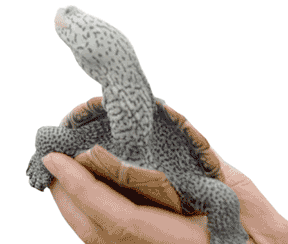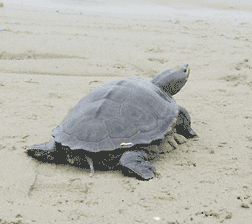|
|
 |
||||||
|
|||||||
There’s Likely to Be a LawTerrapin harvesting ban on the cusp of passingby Carrie Madren
Terrapins — Maryland’s iconic reptilian mascot — live a life of hard knocks. The lucky few — two to four percent of clutches of five to 22 eggs — that make it out of the egg must evade hungry birds and mammals to reach the waters, where they live out their lives. In their element, they must survive in waters humming with motor-boat propellers, mined with deadly crab pots and toxic with pollution, sediment and algae. Those that survive become bounty for watermen making a living on the Bay. Terrapins must fight not only for their own lives but also for their species. Between the ages of eight to 13, females leave the relative safety of the water to find an ever-scarcer sandy beach on which to dig a hole and lay their eggs. Their hard life might get somewhat easier this year, if the General Assembly passes a bill to preserve the Bay’s only turtle from Chinese soup pots. Eating Turtle SoupIn early Maryland, colonists survived on terrapin soup. Then it became a delicacy. Old cookbooks describe a thick, rich, gravy-like soup, laced with sherry. Never able to meet huge demand, the tasty soup faded from gourmet menus in the last century. Today there is virtually no demand for terrapin meat in Maryland, but the diamondback turtle is a delicacy in Asia, especially in China, where native terrapins have been eaten up. China’s demand for turtles would require some 20,000 terrapins a year, says Richard Stanley of the Chesapeake Terrapin Alliance. “And that demand is not going away.” Terrapins are one export we don’t want to make, according to harvesting ban supporters. “We should not allow demand for turtle soup in Asia to harm the Bay,” Karen Meadow, of the Audubon Society of Maryland/DC, told Maryland senators last week. Says Jack Cover of the National Aquarium in Baltimore, “you cannot have your state reptile and eat it, too.” A Long SwimThe only reptile to take to brackish waters, Malaclemys terrapin inhabits marshes and tidal creeks from Cape Cod down the East Coast, around the Florida Keys and across the Gulf Coast to western Texas. So valued are these diamondbacks that 11 states in their range ban terrapin harvesting: Virginia, Delaware, Massachusetts, Rhode Island, Connecticut, North and South Carolina, Georgia, Florida, Alabama and Mississippi, with Texas considering a ban. Maryland, which names its best university athletes Terps after the terrapin, is notably missing from the list. Those bans reflect the increasing rarity of the species. Terrapin populations were reasonably stable until 10 years ago. We know that from mostly anecdotal evidence from biologists and watermen, but a study by Dr. Willem Roosenburg of Ohio University backs up that claim. Over the last 10 summers that Roosenburg has caught and released female terrapins in the Patuxent River, their numbers have declined. For the first 10 years, he caught on average 950 adult females each summer at his research site on the river. Since 2005, that number has decreased to less than 300. In the past decade, numbers have plummeted by as much as 75 percent, Richard Stanley of Chesapeake Terrapin Alliance testified last week in a Maryland Senate committee hearing. Six years ago, terrapin advocates persuaded Maryland to consider protecting its state reptile. In 2001, then Gov. Parris Glendening created the Maryland Diamondback Terrapin Task Force to evaluate terrapins in the Bay. The Task Force determined that terrapins were in a state of decline and needed protections. But the task force recommendations stalled. When Gov. Robert Ehrlich replaced Glendening in 2003, he disbanded the Terrapin Task Force. “We got those recommendations, and then it sat for another five years,” says Marguerite Whilden, Maryland Department of Natural Resources’ terrapin educator and expert, who lost her job to Ehrlich’s cuts. Anne Arundel Del. Virginia Clagett, a member of the task force, tried another tack to save Maryland’s terrapins. In 2006, she introduced a bill to prohibit commercial harvesting of terrapins. By the time the bill passed, it had morphed to another purpose: requiring the Department of Natural Resources to prepare a fishery management plan — just as it does for rockfish or flounder — for terrapins. It’s the department’s job to manage our state’s natural resources so that species thrive while satisfying everybody who wants a part of them. A management plan includes the life history and biological needs of a species, as well as sufficient restrictions on its harvest to allow it to repopulate. The new harvesting regulations, finished last summer, limited the size of turtles that could be caught (four to seven inches long), restricted the harvest season (to three months) and required permits for turtle harvesters. Yet 20 times more terrapins were harvested in 2006 than in 2005, from rivers on the Eastern side of the Chesapeake. Last year’s catch of 10,278 terrapins stunned terrapin advocates. The regulations actually worked against the goal of trying to conserve turtles, explained Terrapin Institute’s Whilden, by allowing smaller turtles to be caught. Maryland lawmakers were outraged. “Six months ago I was lobbied a lot on regulation, and I chose to support it, though I was torn. In hindsight, I made the wrong choice,” said Sen. Paul Pinsky. “It’s going to take at a minimum a moratorium if not a long-term ban to bring them back.” So this year, the terrapin protection bill has been reintroduced in both the House, by Clagett, and in the Senate, by Calvert-St. Mary’s Sen. Roy Dyson. This year, they intend to prevail. “Save your efforts,” Dyson said he told Natural Resources’ new secretary, John Griffin. “The governor’s going to have a bill on his desk before then, and he’ll sign it. He wouldn’t dare show up at the [former Sen. Bernie Fowler’s annual Patuxent River] Wade-In without signing it.” Backing the terrapin harvest ban are green groups from around the state, including the National Aquarium in Baltimore, Chesapeake Terrapin Alliance, Maryland Herpetological Society, Conservation International and more, plus 3,400 signatures of support by Marylanders gathered by Clagett. It’s not just cuteness but also the reptilian reproduction rate that wins terrapins friends. “No turtle on the planet can be harvested over any period of time,” says Tim Hoen of the Maryland Herpetological Society, “Biology cannot support it.” “They reproduce 10,000 times more slowly than blue crabs,” explains Norman Meadow of Chesapeake Audubon. Maryland legislators mean to make us the 12th state to ban terrapin harvesting. Against the CurrentMeanwhile, DNR is holding tight to its prerogative to put a terrapin management plan in place. It opposes the terrapin harvest bill and planned a scoping meeting for February 28 helping solidify new regulations. “Fisheries management is [more] effective [than] legislation, bringing stakeholders and scientists together and taking timely regulatory action,” deputy DNR secretary Eric Schwaab told the Senate hearing. As legislators and regulators write their plans, watermen — who endure about as many hard knocks as terrapins — worry that they’re losing yet another catch. The Maryland Watermen’s Association defends its right to a share of the resource, even though few watermen actually catch terrapin. Only 14 permit-holding watermen harvested terrapins last year. Watermen further argue they don’t deserve all the blame for terrapin decline. “We don’t think that we should have a moratorium [on harvesting] unless we have moratorium on development where terrapin lay their eggs,” said Larry Simms, president of the Maryland Watermen’s Association. “We don’t think that we should have to give it [harvesting] up unless they do something about shoreline development, the real problem.” That’s a valid issue, senator Dyson agreed, saying “we’ve got to do more” to restrict Critical Area development. But in the scales of species survival, watermen seem destined to lose this one. “If we stop harvesting this animal,” says Whilden, who has worked to compensate watermen, “no one’s going to starve to death.” |
|||||||
|
|
|||||||
|
© COPYRIGHT 2007 by New Bay Enterprises, Inc. All rights reserved. |


